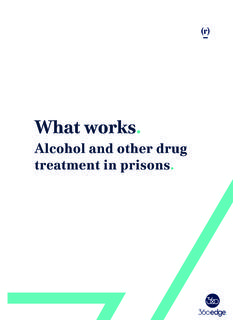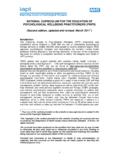Transcription of Improving Access to Psychological Therapies (IAPT ...
1 Improving Access to Psychological Therapies ( iapt ). Outcomes Toolkit 2008/9. July 2008. iapt Outcomes Toolkit 2008/9 (July 2008). Relieving distress, transforming lives . Contents Executive Summary 1. Introduction and checklist 2. Importance of collecting routine outcomes data 3. What information should be collected the iapt Data Set 4. How will information be collected 5. How can the data be used 6. Information governance and consent Glossary of terms Appendices A. iapt Data Set (version ). B. iapt Paper Based Minimum Data Set Questionnaires C. iapt Worker Registration Form (version July 2008). D. Example Patient Information Leaflet 2. iapt Outcomes Toolkit 2008/9 (July 2008). Crown copyright 2008. Executive Summary The iapt programme's success has been defined by its participant's ability to collect routine outcomes data.
2 This data demonstrates the benefits for people using evidenced based Therapies . This toolkit builds on the iapt Implementation Plan and provides guidance on the importance of routine outcome monitoring and outlines collection and reporting mechanisms. The revised recommended iapt data set and the minimum data set are included. The Toolkit also includes a Checklist for services providing a helpful list of first step actions to implement the iapt data set. The Importance of Data Collection The key characteristic of iapt services is their ability to ensure routine data collection. The ongoing management of patient outcomes will ensure services are delivering the right services to the right number of people at the right time and with the right results. The primary purpose of outcomes measurement is to improve people's experience and benefits from the service.
3 It also helps service providers improve their services. Additionally, collection of routine outcomes within iapt services contributes to and helps monitor the delivery of national commitments, including the NHS Vital Signs. What information should be collected The Toolkit defines the full, recommended iapt data set and gives standard inputs and variables, and standard data definitions to support sites to develop a data collection solution. Whilst the collection of the full iapt data set is recommended, a proportion of the data set is mandatory for iapt sites in receipt of CSR funding. This is the iapt Minimum Data Set (MDS). and should be routinely collected by all sites to support iapt Key Performance Indicators. The MDS includes patient data, care pathway data and contact level data. The outcomes measurement tools described in this Toolkit are the most suitable, free to Access tools, and are widely used in practice.
4 How the information will be collected 3. iapt Outcomes Toolkit 2008/9 (July 2008). iapt sites are able to choose their own method(s) of data collection. The Toolkit includes models of data collection used in iapt pilots that ensure data quality and provide feedback on efficiency and effectiveness of data collection. Choice of data collection models will depend on the structure of the service, IT equipment availability and IT systems. Regardless of the method(s) chosen for data collection, it is essential that clinicians and users have Access to up- to-date clinical progress data at each session of The Toolkit offers practical guidance on implementation mechanisms, data collection systems (and what the system should include), dealing with missing data and follow-up data. How can the data be used The recommended iapt data set can be analysed in a number of ways and used by various stakeholder groups including: people receiving care, clinicians, supervisors, commissioners and performance managers.
5 The Toolkit provides guidance on how outcome data may be valuable for these client groups. The Toolkit also provides information and summarises the use of a small proportion of aggregated non-identifiable patient data that flows externally from PCTs to SHA to support regional and national performance monitoring. Information Governance and Consent The use of outcome measuring tools as part of the iapt data set is primarily for the benefit of the patient and consent can therefore be implied. Data can be used to inform treatment and appropriate care pathways. The content, rationale, purpose and benefits of routine outcome measurement should be properly conveyed to patients, and for external use of data, information sharing governance should be observed. Moving Forward The ability to collect routine outcomes data for at least 90% of patients is the defining feature of iapt .
6 This document provides the tools which iapt sites will need to use to achieve this aim. However, we recognise these tools alone will not be enough to ensure success. Consequently, we are working with regional iapt leads to ensure that training and support are available to all iapt sites in this critical first year. 4. iapt Outcomes Toolkit 2008/9 (July 2008). 5. iapt Outcomes Toolkit 2008/9 (July 2008). 1. Introduction The iapt programme's success has been defined by its participant's ability to collect routine outcomes data. This data demonstrates the benefits for people using evidenced based Therapies in terms of: Improved health and wellbeing Helping people retain employment Supporting people back to work and participating in the activities of daily living High levels of satisfaction from people using services and/or their carers Increasing choice and accessibility to clinically effective Psychological therapy services This data has also has been essential in helping services deliver the right service to the right numbers of referrals and people (relevant to the PCT's population), at the right time, and are getting the right results.
7 As iapt services begin to roll out over the next few years, one of the key challenges is replicating these achievements on a much larger scale. This toolkit supports chapter 7 of the iapt Implementation Plan: National guidelines for regional delivery and chapter 8 of the iapt Commissioning Toolkit. It provides a practical and informative framework for use by iapt sites in 2008/9 and includes details of: Routine outcome monitoring and data collection The iapt Data Set and the Minimum Data Set (MDS). Mechanisms to collect and report outcomes data Good practice examples in each chapter This technical document supersedes the iapt Outcomes Framework and Data Collection document of May 2007, which was part of the iapt Pathfinder initiative. To support iapt . expansion sites in 2009/10, further guidance will be published in due course reflecting ongoing policy and informatics developments, including minor changes to the iapt Data Set (where necessary).
8 The checklist below highlights some of the key actions services should be taking now to ensure successful outcome collection. 6. iapt Outcomes Toolkit 2008/9 (July 2008). First steps: A checklist 1. Identify a Data Collection Lead/Information Manager 2. Understand what information should be collected (Chapter 3). 3. Conduct a baseline assessment a. What is your current level of data collection b. How does this differ from the iapt requirement? c. Are you capable of collecting the full requirements, what systems are in place? d. What is your data collection model ( who does what and how?). e. Will your model need to be adapted to meet the requirement? 4. Agree a data collection approach/model (Chapter 4). 5. Identify delivery constraints and resource requirements (including workforce impact and training issues). 6. Develop a local delivery arrangements 7.
9 iapt Outcomes Toolkit 2008/9 (July 2008). 2. Importance of collecting routine outcomes data A key characteristic of iapt services and their therapists is the ability to demonstrate the health and well-being outcomes delivered. Routine outcomes measurement is central to the drive towards improved quality and accountability of services. Routine outcomes measurement offers a means of providing information on health outcomes in an accessible and common format for all stakeholders including service users and carers, the public and health care commissioners 1. The key principles and benefits of outcomes measurement are set out in Table 1. Table 1: Principles and Benefits of Outcomes Measurement Principles The primary purpose of outcomes measurement is to improve people's experience and benefits from the service and is part of ongoing, collaborative service evaluation, with feedback from patients at its heart Outcomes feedback to clinicians helps improve the quality of their interventions Outcomes feedback to supervisors supports case reviews, and collaborative treatment planning Routinely collected outcomes data helps managers monitor and improve overall service performance Service performance data informs PCT/SHA managers who set national standards to aim for Intelligent use of aggregate outcomes data by experts aims to define best practice models of service delivery The requirement for data collection should be proportionate to the treatment being offered.
10 And integrated with clinical priorities. Data is more useful if a complete set of minimum data is obtained for each session Benefits People chart their progress towards recovery and see at what point their psychometric score falls within the normal range. For example, if the goal is to reduce or stop medication, this can help decide when would be an appropriate time People set their own goals for therapy, and give ongoing feedback on whether it is working and which elements are helpful or unhelpful 1. National Institute for Mental Health in England (NIMHE) (2005), Outcomes Measures Implementation: Best Practice Guidance 8. iapt Outcomes Toolkit 2008/9 (July 2008). If people wish, they can ask their carers (loved ones, family, friends) to help set goals, encourage step-by-step changes, and give additional feedback on progress Therapists and supervisors, and the clinical team, can also chart progress, and can adjust treatment plans, if the feedback indicates the current plan is not working.




